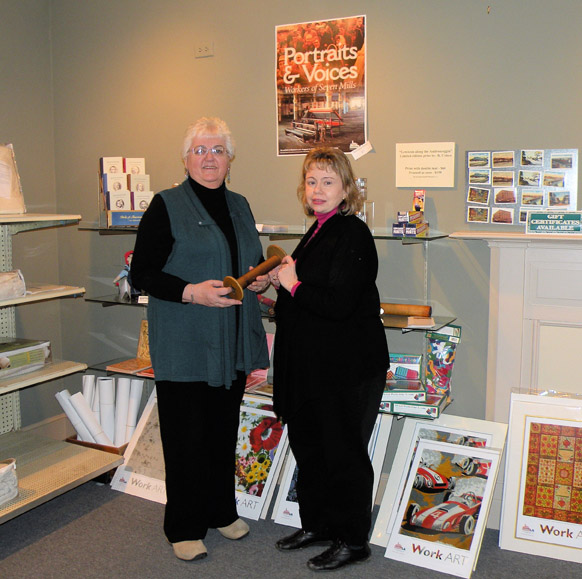Maine’s twin cities of Lewiston and Auburn, along the Androscoggin River were once among the country’s top shoe manufacturers.
At the height of America’s shoe manufacturing years, during the last century, thousands of mostly French-Canadian immigrants, and their family members, were employed by the shoe and textile manufacturing industries located along the river.
These days, the series of large masonry buildings along the river are cavernous structures in transition.
Rachel Baillargeon Desgrosseilliers grew up in Lewiston. She recalls going to the Bates Mill one day to see her father, Cyrille Baillargeon, when he was working.
“He worked on the second floor. It was noisy in the mills. Lint was everywhere,” she recalls.
Today, Desgrosseilliers is the executive director of Museum L-A, located inside the Lewiston mill where her father worked. Her office is in the brightly lit mill building is just one floor below where her father worked for 38 years.
As museum director, Desgrosseilliers says her goal is to protect the history of the textile workers who made the Androscoggin River’s industrial mills successful.
Museum L-A is currently exhibiting “Portraits & Voices: Shoemaking Skills of Generations” in the first-floor galleries, and selections from “Portraits & Voices: Millworkers of Seven Mills” in the museum’s second-floor gallery. Both exhibits feature excerpts from personal histories recorded by oral historian Andrea L’Hommedieu and accompanying portraits by photographer Mark Silber.
The workers are sometimes pictured with their family members. Maine’s Sen. Olympia Snowe is pictured in one portrait standing beside her late aunt, Maria Goranites, who worked in the Jacques, Hill and Continental mills. Goranites worked as a weaver for 11 years.
Retired employees who worked in the Bates Mill, the Libbey Mill, the Hill Mill, the Continental Mill, the Androscoggin Mill, the Edwards Mill and the Pepperell Mill talk about their work experiences. One story from Real Fournier explains how he was only 18 when he went to work in the spinning room at the Androscoggin Mill. “It was my first job,” he recalls. “I didn’t like it.”
Most of the mill workers were Franco-American. They spoke mostly French because their parents were French-Canadian immigrants. Irish workers were the second largest immigrant group.
“Lewiston always was an immigrant community,” says Desgrosseilliers.
In fact, in November 2010, the Museum L-A received a Leaders in Innovation Award from the New England Museum Association in Springfield, Mass., for its 2009 exhibit “Rivers of Immigration: Peoples of the Androscoggin.”
Some original shoe making and textile machines are included in the exhibit. They were protected from export to foreign countries after the mills closed, says Susan Beane, the archivist and public relations coordinator for Museum L-A.
A typical mid-century shoe worker’s home furnishings, including a donated antique Zenith floor radio and a Westinghouse refrigerator, are among the visual enhancements to the shoe workers’ exhibit.
Two shoe manufacturing companies still operating in Lewiston are the Rancourt Company and Falcon Performance Footwear, both featured in the exhibit. A video demonstration narrated by Michael Rancourt explains how hand-sewn shoes are a legacy of the shoe maker.
“Hand lacing shoes is a trade dating back to the 1870s,” says Rancourt.
A corner of the shoe workers exhibit features Maine retailer Lamey Wellehan, which first opened in 1914 on Lisbon Street in Lewiston. Photographs of its founders, Charles Lamey and Daniel Wellehan, are included.
“Portraits & Voices: Shoemaking Skills of Generations” will be extended and expanded this year, says Beane. A lecture series will include hand-sewing demonstrations and stories of some of the area’s prominent shoe manufacturers.
Museum L-A is located in the Bates Mill Complex in Lewiston. Information about the exhibit can be found at www.museumla.org.
Send questions/comments to the editors.



Success. Please wait for the page to reload. If the page does not reload within 5 seconds, please refresh the page.
Enter your email and password to access comments.
Hi, to comment on stories you must . This profile is in addition to your subscription and website login.
Already have a commenting profile? .
Invalid username/password.
Please check your email to confirm and complete your registration.
Only subscribers are eligible to post comments. Please subscribe or login first for digital access. Here’s why.
Use the form below to reset your password. When you've submitted your account email, we will send an email with a reset code.